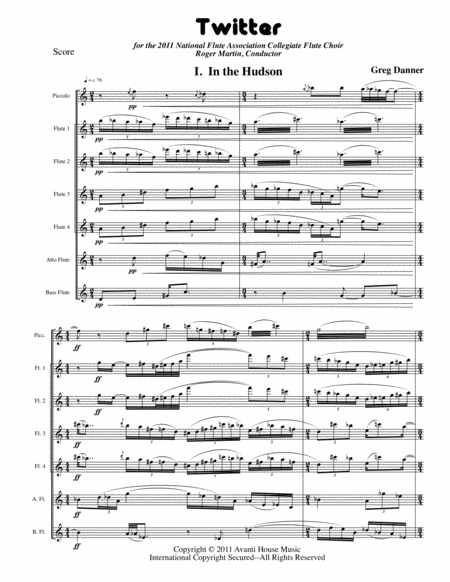Woodwind Ensemble Flute - Level 3 - Digital Download SKU: A0.778282 Composed by Greg Danner. 20th Century,Contemporary. 80 pages. Avanti Music #2967835. Published by Avanti Music (A0.778282). Twitter, founded in March of 2006, is a social networking and micro-blogging service that allows users to post short messages of no more that 140 characters. Because it works as an application on cell phones people can share information immediately. In its short time, Twitter has become embedded in our increasingly networked society. The composition Twitter takes five famous tweets-some serious, others funny, and some historic and presents a musical interpretation. In keeping with the idea that a tweet is a short message, each movement of Twitter is approximately 140 seconds long. 1. There’s a plane in the Hudson. I’m on the ferry going to pick up the people. Crazy. Janis Krums, 12:36 p.m. Jan15, 2009Janis Krums posted this text and the first photo of US Airways flight 1549 moments after the plane made an emergency landing in the Hudson River after hitting a flock of birds. His quick action helped to notify rescue workers and the media. 2. Today I interviewed a squirrel in my backyard and then threw to commercial. Somebody help me.Conan O’Brien, 3:54 p.m. Feb. 24, 2009 Shortly after being dismissed from the Tonight Show and finding himself in-between jobs, Conan O’Brien joined Twitter. As with many celebrities, a Twitter account can allow fans to stay in touch and feel connected. What was amazing in this case was that in just two hours after this first tweet he had over 125,000 followers-the largest number ever in such a short time. His number has since grown to nearly 3 million. 3. ArrestedJames Buck, 9:30 a.m. April 10 A graduate student from the University of California-Berkeley, James Buck was covering an anti-government protest in Egypt. Buck was caught up in a demonstration, and while being taken to jail had time to post a one-word tweet-arrested. Within seconds colleagues in the United States got word of his arrest and notified the university, the US Embassy, and a number of press organizations on his behalf, leading to his freedom. 4. We just made history. All of this happened because you gave your time, talent and passion. All of this happened because of you. Thanks. Barack Obama, 11:34 a.m. Nov. 5, 2008 The Obama 2008 campaign was historic on a number of counts, and the use of technology and social media was one of them. This tweet was sent to over 2.6 million followers just after the election. 5. Are you ready to celebrate? Well, get ready: We have ICE!!!!! Yes, ICE, *WATER ICE* on Mars! w00t!!! Best day ever!! MarsPhoenix, 5:14 PM Jun 19th, 2008 NASA’s Jet Propulsion Laboratory has made an innovative use of twitter by sending messages from the Mars Phoenix lander’s point of view. The message above is undoubtedly the most exciting news ever to be tweeted on behalf of an extraterrestrial robot.
